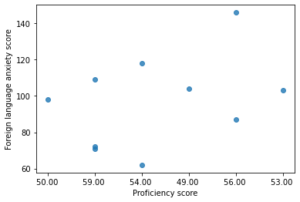Learning Content & Research-Based Teaching
Student Project Showcase
Do English Language University Students Experience Foreign Language Anxiety?
by Lara Božić (University of Rijeka)
If you have ever studied a foreign language, you have probably experienced some degree of foreign language anxiety. According to Peter D. MacIntyre and R. C. Gardner, foreign language anxiety (or FLA) is a feeling of pressure and nervousness that is particularly linked with situations involving second language use, such as speaking, listening and acquiring new knowledge. According to Şenel Elaldı, at least a third of all foreign language learners experience some level of FLA. Iva Šimek discovered that some students also feel scared of being ridiculed during their foreign language class activities, while Elias Bensalem found that English foreign language students mostly feel peer pressure, especially when it comes to making mistakes in pronunciation. Since I have also experienced some FLA during my undergraduate and graduate studies in English Language and Literature, I wanted to see whether my colleagues felt the same.
What was the aim of my study?
The aim of my study was to see whether there is a relationship between FLA and foreign language proficiency, the latter defined by Margaret Thomas as “a person’s overall competence and ability to perform in L2”. I formulated two research questions:
- What levels of FLA do English language and literature university students experience?
- Do more proficient students experience less FLA than less proficient students?
How did I collect and analyse the data?
The easiest way to determine the level of FLA is to ask students straightforward questions about it. For this reason, I used the Foreign Language Classroom Anxiety Scale (FLCAS), a widely used research instrument designed by Elaine K. Horwitz, Michael B. Horwitz and Joann Cope, which consists of 33 statements, each accompanied by a five-point Likert scale ranging from 1 (strongly agree) to 5 (strongly disagree). I adopted the scale from Elias Bensalen, minimally changing the wording of some statements (that is, I replaced “English” with “(foreign) language” in statements 1 and 3 to make the statements more uniform). The statements I used can be found in Table 2 below. Due to the way the statements are formulated, in most cases, the answer “strongly agree” indicates a high level of anxiety and the answer “strongly disagree”, a low level of anxiety. For the statements with an asterisk, which are worded in the opposite way, the answer “strongly agree” indicates a low level of anxiety and the answer “strongly disagree” points to a high level of anxiety. The mean scores can range from 33 to 165; lower scores indicate higher anxiety, and higher scores lower anxiety. Since I wanted to see how foreign language proficiency affects FLA, I also used the Oxford Placement Test, which measures general knowledge of the English language.
I copied the proficiency test along with FLCAS in a Google form and distributed it among my peers in the English Department at the University of Rijeka. Unfortunately, I discovered that students aren’t too keen on taking part in other students’ research. The response rate was rather low – only ten students in total participated. The distribution of participants across years of university study can be seen in Table 1.
Table 1. Distribution of participants across years of university study
| Year of Study | Frequency | Percentage |
| First-year undergraduate | 3 | 30% |
| Second-year undergraduate | 1 | 10% |
| Third-year undergraduate | 3 | 30% |
| First-year graduate | 2 | 20% |
| Second-year graduate | 1 | 10% |
Nonetheless, I wasn’t discouraged. Instead, I put my coding skills to the test and used the Python programming language in Google Colaboratory to analyse the data. I calculated frequencies, percentages, arithmetic mean, standard deviation and Spearman’s rank correlation.
Firstly, I wanted to see what FLA-level students experience. In order to do this, I calculated the mean and standard deviation for each statement. For the statements with an asterisk at the end, which were phrased in the opposite way, I reversed the numerical values. More precisely, for ‘strongly agree’, I changed the value from 1 to 5; for ‘agree’, I changed the value from 2 to 4; for ‘disagree’, I changed the value from 4 to 2; for ‘strongly disagree’ I changed the value from 5 to 1; the value for ‘neither agree nor disagree’ remained unchanged. As you can see in Table 3, I have found that 30% of the participants experienced low levels of FLA, 50% felt moderate levels of FLA and 20% had high levels of FLA. I had adopted anxiety levels from Bensalem.
Table 2. Participants’ scores on FLACS
| Statement | Mean | SD |
|
2.3 | 1.159502 |
|
2.0 | 0.816497 |
|
2.9 | 1.197219 |
|
3.3 | 1.251666 |
|
3.4 | 0.843274 |
|
2.2 | 1.135292 |
|
2.5 | 1.269296 |
|
2.6 | 0.966092 |
|
2.5 | 1.269296 |
|
2.3 | 0.823273 |
|
2.8 | 1.229273 |
|
2.5 | 1.433721 |
|
2.4 | 1.429841 |
|
3.4 | 1.429841 |
|
3.2 | 1.316561 |
|
2.7 | 1.418136 |
|
3.3 | 1.494434 |
|
2.6 | 1.074968 |
|
3.2 | 1.398412 |
|
2.5 | 1.509231 |
|
4.3 | 1.251666 |
|
3.5 | 1.178511 |
|
2.4 | 1.264911 |
|
2.4 | 1.264911 |
|
3.6 | 1.429841 |
|
3.2 | 1.475730 |
|
2.8 | 1.475730 |
|
3.4 | 1.349897 |
|
3.8 | 1.135292 |
|
4.2 | 0.788811 |
|
3.4 | 1.577621 |
|
2.9 | 1.100505 |
|
2.5 | 1.178511 |
* Items are reverse-coded
Table 3. Participants’ anxiety levels
| Scores | Level of FLA | Frequency | Percentage |
| 33 – 79 | High | 3 | 30% |
| 80 – 117 | Moderate | 5 | 50% |
| 118 – 165 | Low | 2 | 20% |
Secondly, I wanted to explore whether more proficient students experience less FLA than less proficient students. For this purpose, I calculated Spearman’s correlation coefficient, which measures the degree of association between two variables – in this case, foreign language proficiency and FLA. According to the results of the Oxford Quick Placement Test, half of the participants were Advanced and half were Very Advanced in English (see Table 4).
Table 4. Participants’ proficiency levels
| Scores | Proficiency levels (ALTE, CERF) | Frequency | Percentage |
| 48 – 54 | Advanced (C1) | 5 | 50% |
| 55 – 60 | Very Advanced (C2) | 5 | 50% |
Spearman’s correlation coefficient equated to rs = -0.179, ps = 0.620, suggesting that there was a very weak correlation between FLA and foreign language proficiency. This can be seen in Figure 1.
Figure 1. Correlation scatterplot of proficiency score and FLA scores

What did I conclude from the study?
By conducting this study, I received a scientific answer to my layperson question: “Do my peers experience FLA as well?”. The results I obtained confirmed the findings of the papers I had read: students experience a moderate level of anxiety (M = 97, SD = 25.16), which coincides with previous research conducted by Bensalem , Eledi and Šimek , where the students experienced an overall moderate level of anxiety, as well. What was interesting is that the students most strongly disagreed with the statement “I don’t worry about making mistakes in language class”, which indicates that many students have a fear of negative social evaluation, which eventually leads to feelings of tension and nervousness – just what I had mentioned at the beginning of this post.
What do the results imply?
I believe that conducting research studies on FLA is very important. They help us understand why it arises and how we can overcome it. They also provide us with a basis for our future actions as foreign language teachers.
As a future teacher of English, I would like to create an optimal learning environment for my students. Paying attention to FLA and making sure my class is a safe space for students seem like the first steps to me. In my opinion, foreign language teachers should engage students in anxiety-provoking class activities and work with them to minimise the impact of FLA.
I would love to repeat this study in the future with a larger number of participants. Also, I would love to include primary and secondary school students in it to get an insight into how they experience FLA. All of this could help foreign language teachers find ways to prevent or reduce FLA in the classroom.
In the end, I hope you have enjoyed reading about my study and perhaps got an idea or two for conducting one yourself!

Lara Božić
I have recently obtained my BA in English Language and Literature as well as Pedagogy from the Faculty of Humanities and Social Sciences at the University of Rijeka, Croatia. Currently, I’m pursuing my MA in the same faculty with the goal of becoming an English language teacher and education specialist. My interests lie in contemporary literature, feminism and film. In fact, I’m currently working on my MA thesis, which focuses on a postfeminist analysis of Sally Potter’s “Orlando”. With my passion for education and knowledge of literature, I hope to inspire future generations of English learners.
View my LinkedIn profile
